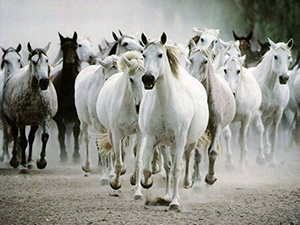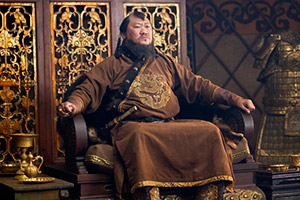During his 17 years as special emissary to Kublai Khan, Marco Polo celebrated the lunar new year in both the Chinese and Mongolian traditions, the former during his three years on political assignment in Quinsai (today’s Hangzhou) and the latter during his more frequent stays in the City of the Khan’ (today’s Beijing).
 The Mongolians call the Lunar New Year Tsagaan Sar or White Moon (you might recall the title of episode 6 of Marco Polo which is set during this new year festival). As Marco recalls in his writings “the Great Khan and his subjects dress themselves in white robes, both men and women, because white dress seems to them both lucky and good, and therefore they wear it at the beginning of their year so that they may take their good and have joy all year.”
The Mongolians call the Lunar New Year Tsagaan Sar or White Moon (you might recall the title of episode 6 of Marco Polo which is set during this new year festival). As Marco recalls in his writings “the Great Khan and his subjects dress themselves in white robes, both men and women, because white dress seems to them both lucky and good, and therefore they wear it at the beginning of their year so that they may take their good and have joy all year.”
As I learned long ago from my Mongolian friends, the white month is a time to celebrate overcoming the brutal Winter successfully and welcoming Spring. All debts from the previous year are paid off, relationships are mended, and major household cleaning and renewal is organized. While Polo was correct that the wearing of all white was “lucky and good,” it mostly represents a fresh, new start.
Of course, Kublai Khan tended to do things a bit differently-and on a grander scale- which is only one reason why he came under much criticism from his grassroots relatives in the Motherland
 Marco Polo respectfully observed the customs as Mongol barons presented white silks to the Khan – and more. According to Marco, they gifted Kublai great volumes of silver, gold, pearls, rare gems and white camels and horses. How many albino animals? In one translation of Marco’s accounts the number was 5,000. In another it’s 12,000. Still, in another translation the white camels and horses number 100,000. No one is certain who exaggerated such numbers in one handwritten translation to the next, but keep in mind that this is a major reason that Marco was given the notorious label II Milione (Marco of the millions) when the various copies made the rounds.
Marco Polo respectfully observed the customs as Mongol barons presented white silks to the Khan – and more. According to Marco, they gifted Kublai great volumes of silver, gold, pearls, rare gems and white camels and horses. How many albino animals? In one translation of Marco’s accounts the number was 5,000. In another it’s 12,000. Still, in another translation the white camels and horses number 100,000. No one is certain who exaggerated such numbers in one handwritten translation to the next, but keep in mind that this is a major reason that Marco was given the notorious label II Milione (Marco of the millions) when the various copies made the rounds.
Suffice it to say, the Khan was presented with an impressive amount of white livestock to celebrate the sacred holiday. It was then that Kublai had his own elephants paraded out as a kind of high-end catering service – 5,000 of them “all covered in beautiful clothes worked richly in gold and in silk,” and carrying coffers filled with feasting items and silver utensils. Anyone need a fork? The elephants are here.
Looking back on all this from his prison cell in Genoa years later, Marco told his cellmate Rustichello that it was “the most wonderful and beautiful sight that was ever seen in this world.”
But the best was yet to come:
In his Great Hall, the Khan presided over 12,000 barons whom the Khan presented with 13 robes each (all of a different color) and “belts of crimson, cunningly worked with threads of gold and silver.” While the critics back home in 1300’s Venice found these statistics suspect, according to historians like Bergreen, Mongol and Chinese annals confirm these figures (on that note, let us remember that most historians today validate Marco’s accounts as mostly-true and highly relevant).
 But what was it that Marco remembered most about such celebrations? A very special guest who approached the royal pavilion on all fours and kowtowed before the Khan of Khans. As Marco looked on in awe, a massive tiger was brought before the Khan. “As soon as he sees the great lord, the tiger throws himself down…and is so tame that he stays thus before him with no chain, quietly before the king’s feet, like a dog.” Reflecting on the sight years later, Marco said, “it makes one wonder.” I have always loved that understatement. It makes one wonder.
But what was it that Marco remembered most about such celebrations? A very special guest who approached the royal pavilion on all fours and kowtowed before the Khan of Khans. As Marco looked on in awe, a massive tiger was brought before the Khan. “As soon as he sees the great lord, the tiger throws himself down…and is so tame that he stays thus before him with no chain, quietly before the king’s feet, like a dog.” Reflecting on the sight years later, Marco said, “it makes one wonder.” I have always loved that understatement. It makes one wonder.
So, during this 2015 celebration of the Year of the Blue Sheep, I imagine young Marco, dressed in white (and, at a later time, perhaps a crimson belt), mingling among princes, barons, Khan cousins, astrologers, Tibetan monks, and falconers, feeling the buzz of fermented mare’s milk (still wondering about that tiger) and wishing the elders an “Amar mend uu” – good health and peace. Or “Fast horse and a light rein to you, my friend.” For Marco Polo, each new year in Asia undoubtedly held the exciting promise of more classified missions by order of the Khan, more mysteries to unravel, more dangerous terrain to navigate and report on. As Marco said himself, years later on his death bed when that II Milione criticism dogged him, “I did not tell half of what I saw.”
It makes one wonder.
Wishing everyone a safe and bountiful journey of your own in this Lunar New Year. Amar mend uu – good health and peace. And, as always, a fast horse and a light rein.









